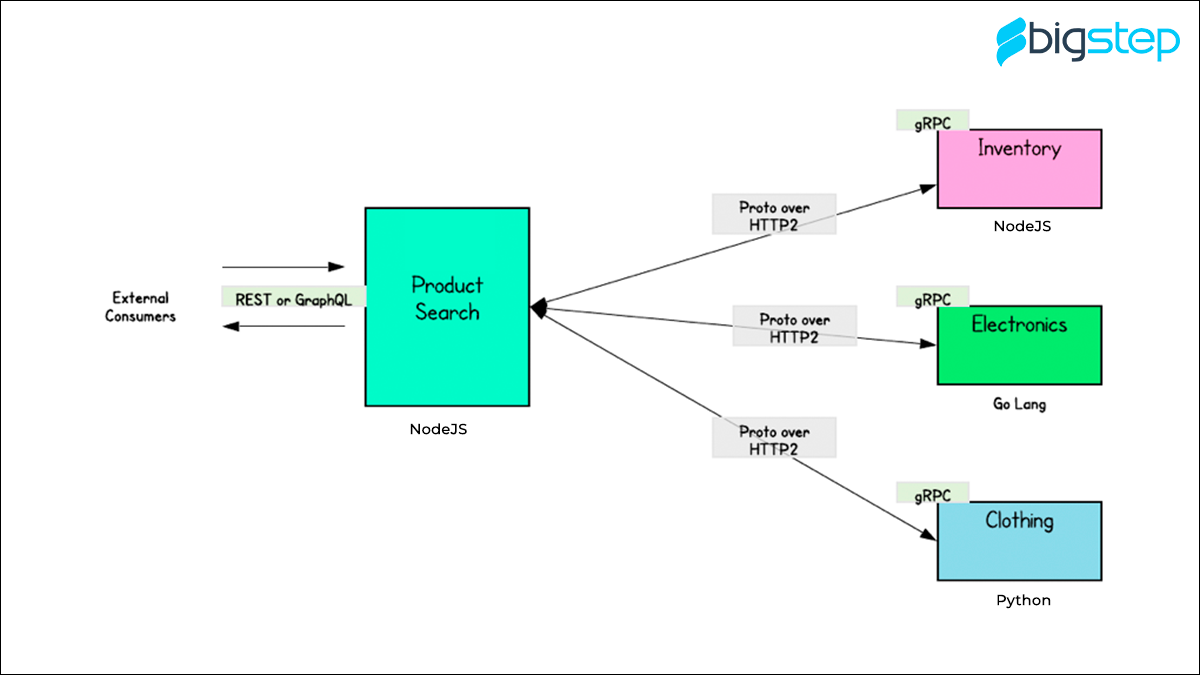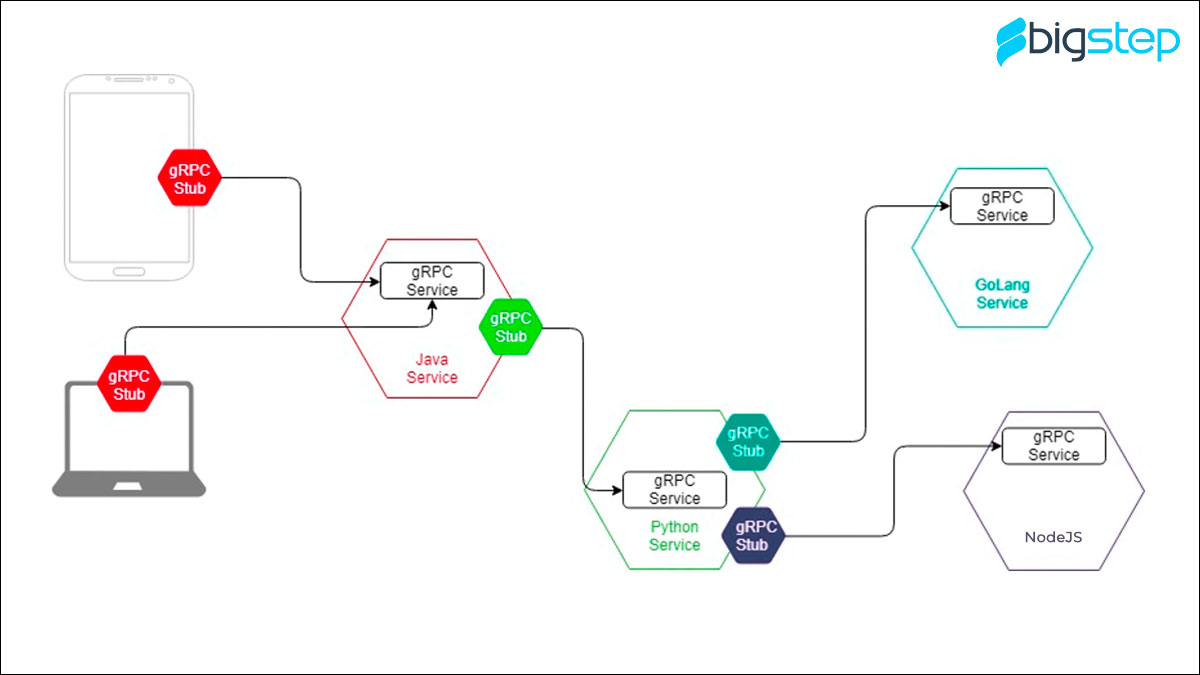How gRPC can Change Real-World Microservices Forever

Microservices-based architectures have been helping organizations globally. Be it better performance, less downtime, reduced costs, or scalability, microservices enable numerous benefits, especially related to monolithic designs.
The perks of using microservices are apparent, and a primary reason behind their popularity is brands’ knowledge of the technology. For a long time, organizations have been using REST (Representational State Transfer) as the standard communication technology while implementing microservices.
The technology has helped companies since its inception in 2000; however, the emergence of gRPC has revolutionized the space. Organizations are realizing that instead of using a text-based messaging protocol, leveraging a binary protocol designed for inter-service communication is a far better choice.
Google understood the need of building a uniform way to define message interchange formats and service formats. This laid the foundation for gRPC or gRPC Remote Procedure Calls, the modern microservices communication system. Despite initially releasing in 2015, Google made a stable release for the technology in late 2021.
Given gRPC’s relatively new entry into the market, most organizations do not understand its workings. That’s why the article will talk about gRPC and how it is the ideal choice for establishing inter-microservices communication.
What is gRPC?
gRPC by Google is a modern, open-source, universal, high-performance communication protocol that can operate in any space. It stands for gRPC Remote Procedure Calls and is based on Stubby, an internal framework project by Google.
gPRC can connect services across data centers alongside pluggable support for tracing, authentication, health checking, and tracing. Given Google’s awareness regarding the space, the company ensured that gRPC is as efficient and performant as possible. That’s why gRPC requires minimal processing throughout the marshaling and unmarshaling process.
However, being a Google product is not the only attribute that makes gRPC an ideal inter-microservices communication protocol. The secret behind its performance lies in the manner it handles serialization of structured data. Here is a quick overview of Proto or Protocol Buffers in gRPC to understand its benefits:
- Machine Readable: Proto are machine-readable, meaning that they can exchange messages across solutions.
- Efficient: Proto are descriptive and verbose; however, they are more efficient, smaller, and offer better performance.
- Generators: Compiling Proto to source codes alongside programming language’s runtime libraries is simple.
- Compatible with Types: Users can add validations and specify field types in .proto.
Read More: Distributed Transactions, a challenge in the Microservices World

How to Get Started with gRPC?
Getting started with gRPC is quite simple on a basic level. Here are the fundamental steps to use gRPC:
1. Start by defining the service definition file in the .proto file.
2. Now, release the client and server-side stubs from the Protocol Buffer file.
3. Integrate the service in any of the supported languages.
4. Then integrate the client, which triggers the service using the stub.
5. Run the client and the server.
How Does It Work?
While the concept behind RPC seems complicated, its work can be summed into a few steps. Here is a quick brief of how the protocol works:
1. It starts with any client app making a local process call to the client stub that contains parameters to be migrated over to the server.
2. These parameters are serialized via the client stub, which uses a procedure named marshalling.
3. The request is then forwarded to the client time library.
4. Similarly, the library proceeds the request to the higher server stub.
5. After receiving the request on the server run-time library, the server stub process is called.
6. Then the allowed parameters are unpacked by the server stub.
7. The next step involves the actual procedure being called.
8. Finally, the client stub receives a response from the server stub.

What Languages and Platforms It Supports?
Another prominent reason behind gRPC’s industry-changing potential is its compatibility. The protocol supports several mainstream platforms and client libraries, including:
Platforms
- Android
- iOS
- Windows
- Linux
- MacOS
Client Libraries
- Ruby
- Java
- Python
- C++
- Objective-C
- C#
- Node.js
- Go
- PHP
- Dart
Read More: Why is Agile Software Development Crucial for Building Solutions?
The Benefits of Implementing gRPC
If you are still thinking how gRPC can revolutionize the microservices’ development, the following perks will shed some light on it:
Enables Better Speed than REST
Since gRPC is based on the binary protocol buffer format, it is significantly lighter than the text-based formats, like JSON. It allows gRPC to enable much faster speed than standard JSON-based RESTful APIs as well.
Robust and Well-Defined
gRPC comes with a strong type and defined service that eliminates errors related to run time. Client apps can see it like the local method as it helps them scale microservices in an efficient manner.
Extensive Language and Platform Support
As already mentioned, gRPC’s support extends to numerous platforms and libraries. It allows organizations to write microservices that suit their needs without facing any interoperability failures.
Premium Stream Support
With gRPC, ventures can conduct both server and client-side streaming. They only need to change the service definition to enable the support. It is as simple as sending a response with the keyword – stream.
Is gRPC Limited to Microservices?
gRPC’s versatility makes it a revolutionary addition to the market. The protocol is ideal for microservices’ development; however, it can also enable quality support for APIs, integrations, and client-server apps.
Microservices: The protocol connects servers within service-centric spaces, regardless of the organizations’ scale or nature.
Client-Server Apps: It also bodes well with client-server apps where the client apps run on mobile or desktop. Since gRPC uses HTTP/2 in network and latency utilization, it provides better support for the applications.
APIs and Integrations: The protocol can also offer APIs across the internet for app integration with third-party services. It facilitates optimal exposure to the APIs and services.
Wrapping Up
gRPC is a worthy successor to REST as the protocol excels on various fronts. However, that does not make gRPC an outright better solution or a universal fit. Choosing between any communication protocol boils down to your needs, resources, and expertise.
The best way to find out which protocol works best for you is to reach experts like BigStep Technologies. With over 13 years of experience, our experts can help you comprehend and implement such protocols without any hitch.
You can reach us at info@bigsteptech.com for quick and seamless assistance.
karishma Verma
Content writer with a passion to write for a variety of niches to broaden my horizon as a professional writer.
Everything to Know About Service Mesh: Features, Pros & Architecture - BigStep Technologies
Posted at 12:48h, 29 April[…] Read More: How gRPC can Change Real-World Microservices Forever – BigStep Technologies […]
Everything to Know About Service Mesh: Features, Pros & Architecture - BigStep Technologies
Posted at 13:10h, 29 April[…] Read More: How gRPC can Change Real-World Microservices Forever […]